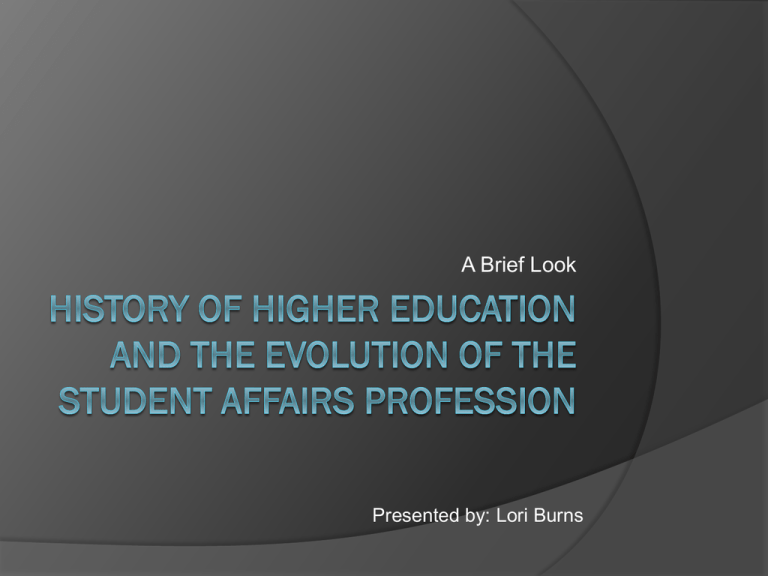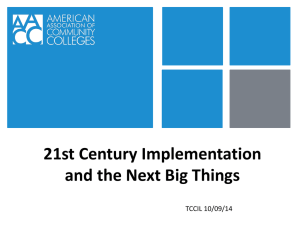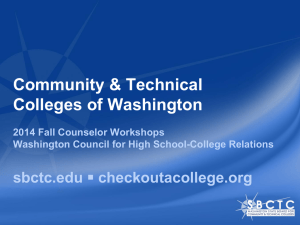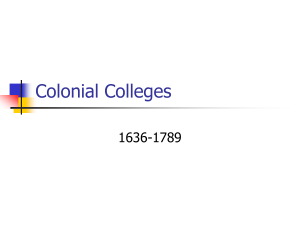History of Higher Education
advertisement

A Brief Look Presented by: Lori Burns The Colonial Period The “Oxbridge” Model: Refers to the system of higher education put into place by Oxford and Cambridge Both were English universities that developed a formal system of endowed colleges that combined living and learning within quadrangles The college was an isolated, “total” institution whose responsibilities included guiding both the social and academic dimensions of undergraduate life It was this modeled that influenced college builders in the New World The Colonial Period Colonial Period Cont. The American colonist built colleges because they believed in and wished to transplant and perfect the English idea of an undergraduate education as a civilizing experience that ensured a progression of responsible leaders for both church and state. Colonial colleges incorporated a tight connection between the college board and its host civil government, fostering both responsible oversight and a source of government funding from taxes, tolls, and lotteries. The Colonial Period Early Colleges Harvard Founded in Massachusetts Bay colony in 1636 The College of William and Mary Founded in Virginia in 1693 Yale Founded in Connecticut in 1701 The Colonial Period Characteristics of Early College Life A majority of institutions developed denominational ties Religious concerns and sectarian competition often fueled the creation of colonial colleges Most college presidents were men of the cloth Tension between faculty and students In residential colleges complaints would range to dissatisfaction with the dining commons to dissatisfaction with the curriculum sparking riots and revolts from the students In loco parentis – put the faculty in the position of supervising student conduct as well as their moral development The Colonial Period Characteristics of Early College Life Enrollment and Completion Confined to White males, mostly from established, prosperous families Attendance tended to ratify or confirm existing social standing rather than provide social mobility There was little emphasis on completing a degree The Colonial Period The National Period Following American Independence in 1776 and extending into the midnineteenth century Time of the Civil War and the Morrill Land Grant Act Saw the introduction of extracurricular activities, a shift in socioeconomic status of students, introduction of women and African Americans into higher education The National Period The Civil War In the South the Civil War lead to a depletion of student and faculty and to physical damage to the colleges themselves Provided opportunities to initiate new higher education programs Provided a political opportunity to push through legislation that had been stalled Morrill Land Grant Act is an example of this (Thelin, 2004) The National Period Morrill Land Grant Act Passed in 1862 Piece of federal legislation that lead to better access to higher education Originally set up to establish institutions in each state to educate people in agriculture, home economics, mechanical arts, and other practical occupations Helped shift curriculum from classical to more applied studies The National Period Extracurricular Activities Included literary societies, debating clubs, and service groups Considered to be the roots of the extensive university library of today Analysis of extracurricular activities shows that students exerted great influence on the life of their college and determined which activities and values were emphasized The National Period Changing of the Student Body A change in the socioeconomic make up of students occurred Students from a wide range of incomes replaced the more homogeneous group, referred to as a convergence of “paupers to scholars” First-generation college students came from farming families, many of which were older than the usual 17-21 year olds This also led to the formation of charitable trusts and scholarship funds to help colleges provide financial aid to this group of students The National Period Changing of the Student Population Women became formal participants in higher education by the mid-nineteenth century “Female academies” and “female seminars” were created These offered a range of courses and instructional programs beyond elementary and secondary education Curricula included home economics as well as formal instruction in sciences, mathematics, foreign languages, and compositions By the 1860s and 1870s many female seminaries became degree-granting colleges The National Period Changing of the Student Population Between 1865 and 1910 provisions were made for African Americans to pursue higher education The Land Grant Act of 1890 provided funding for Black colleges offering studies in agriculture and mechanical arts Other funding for Black colleges came from Northern philanthropic groups, Black churches, and a mix of federal and state appropriations The National Period The National Period Nearing the end of the nineteenth century there were multiple college models ranging from comprehensive institutions with diverse student bodies to special-purpose colleges serving more distinct, specific groups of students The National Period The Rise of the University Between 1870 and 1910 America witnessed a dramatic “university movement” which involved the following Annexation of professional schools such as medicine, law, business, theology, pharmacy, and engineering Creation of extracurriculars including athletics, fraternities, sororities, campus newspapers, and other clubs Beginning of organized alumni associations The National Period Higher Education after World War I: 1915-1945 Enrollment rose during the Great Depression due to lack of employment opportunities Beginning in the 1920s institutions enjoyed the luxury of choice There began to be more applicants than spots open This lead to the creation and refinement of the Scholastic Aptitude Test (SAT) Diversity was still an issue and discrimination still existed for minority groups The “Golden Age”: 1945-1970 Saw an academic revolution in which colleges and universities acquired unprecedented influence in American society In 1947 Harry S. Truman authorized a report to expand the access and affordability to higher education There was also effective lobbying for the expansion of government and foundation sponsored research grants for university scholars The Golden Age World War II Following the declaration of war colleges accelerated the progress of students in college Military services established cooperative on-campus programs for the training of officers, pilots, and other specialized personnel (Fincher, 2001) The Golden Age The GI Bill The Servicemen’s Readjustment Act, also known as the GI Bill, made federal scholarships for postsecondary education available for returning war veterans It set a precedent for making portable government student aid an entitlement Provided a policy tool for increasing diversity of American universities The Golden Age The 1960s Rise of the “Multiversity” Consisted of a flagship campus with advanced degree programs Enrollment often exceeded twenty thousand students Budget relied on “soft money” of research and development projects funded by the federal government and private foundations The Golden Age The 1960s The Downside to Expansion Students began to complain of large lecture classes, impersonal registration, crowded student housing, and the psychological distance between faculty and students caused by booming campuses Student concern over external political and social events (Vietnam, the draft, Civil Rights) sparked the widespread of student activism By 1970 national media portrayed the American campus as a battleground in a protracted generational war between college students and the established institutions associated with adult society The Golden Age Era of Adjustment & Accountability: 1970-1990 Introduction to more financial aid opportunities Federal government introduced large scale entitlements for student financial aid ○ Basic Educational Opportunity Grants ○ Supplementary Educational Opportunity Grants (later known as Pell Grants) Era of Adjustment Era of Adjustment & Accountability: 1970-1990 Continual rise in diversity of students Traditional image of “Joe College” was being replaced by: ○ Women ○ Native Americans ○ African Americans ○ Asian Americans ○ Hispanics Era of Adjustment Era of Adjustment & Accountability: 1970-1990 Uncertainties of campus futures Institutions were facing financial hardships in the late 70s early 80s Enrollment declines were answered by the recruitment of older students, women and minorities By 1990 higher education saw more financial hardships with state revenues coming up short ○ This prompted educational leaders and critics to consider the need for a fundamental shift in attitudes towards higher education and the collegiate structure in the US. Era of Adjustment From the 20th to the 21st Century: 1990 - 2001 Between 1990 – 2000 most colleges and universities were prosperous and had high enrollments Colleges and student affairs officials still had concerns about how to rethink the college campus and college experience to acknowledge the qualitative and quantitative changes of the recent past Concerns about rising college cost still persisted 20th - 21st Century From the 20th to the 21st Century: 1990 - 2001 Student services accounted for a substantial portion of the higher costs By 2000 the diversity of students helped influence the shape and structure of the institution Women became a decisive majority of student enrollments at both private and public institutions 20th - 21st Century From the 20th to the 21st Century: 1990 - 2001 With the rise in diversity of student there was also a rise in campus leadership groups Tribal Colleges gained autonomy and funding after deliberations with federal and state governments Distance learning emerged due to technological advances 20th - 21st Century From the 20th to the 21st Century: 1990 - 2001 Student affairs leaders now faced how to embrace changes in the national culture while still providing a campus experience that will be substantive and distinctive 20th - 21st Century References Fincher, C. (2001). Higher Education in World War II. IHE Perspectives , 8. Komives, M. F. (2007). Student Services: A Handbook for the Profession. New York: Jossey-Bass. Lightcap, B. (n.d.). Retrieved November 12, 2008, from www.nd.edu/~rbarger/www7?morrill.htm Thelin, J. R. (2004). A History of American Higher Education. JHU Press.






